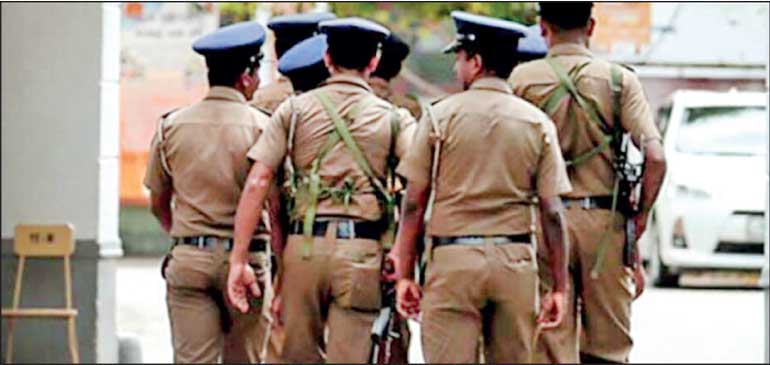Saturday Dec 27, 2025
Saturday Dec 27, 2025
Saturday, 25 October 2025 00:39 - - {{hitsCtrl.values.hits}}

When officers of the law and interpreters of the law stand opposed, justice becomes vulnerable
 As a Police officer who has served this nation for over four decades — beginning my career as a Sub-Inspector and rising through the ranks to Senior Superintendent of Police — I write these reflections not merely as an observer, but as one who has lived the law from within the uniform.
As a Police officer who has served this nation for over four decades — beginning my career as a Sub-Inspector and rising through the ranks to Senior Superintendent of Police — I write these reflections not merely as an observer, but as one who has lived the law from within the uniform.
I come from a proud line of policemen: a third-generation officer and the son of a constable who rose to the rank of Chief Inspector. Over the years, I have served as Officer-in-Charge of police stations across the country, Headquarters Inspector of Galle, Assistant Superintendent of Police in Galle and Hambantota, and later as Deputy Director of Counter Terrorism at the State Intelligence Service. Following retirement, I had the privilege of serving as a diplomat abroad and as an Investigation Advisor at the Financial Crimes Investigation Division (FCID).
It is from this lifetime of service — witnessing both the strengths and the shortcomings of our system — that I reflect on a troubling incident and its deeper meaning for the institutions entrusted with justice.
The emblem, the motto and its promise
“Dhammo Bhave Rakkhati Dhammachari” – “He who lives by the Dhamma (law) is protected by the Dhamma.”
The emblem of the Sri Lanka Police stands for courage, justice, honour, and moral integrity. The elephant in the Sri Lanka Police emblem symbolises the noble qualities that define the spirit of policing — strength, wisdom, discipline, and dignity. Revered in Sri Lankan culture as a creature of immense power and intelligence, the elephant represents the ability to exercise authority with calm restraint and moral courage. Its presence in the emblem reflects the ideal that true strength lies not in aggression, but in controlled and purposeful action. It also connects the Police Service to Sri Lanka’s royal and cultural heritage, where the elephant served as a symbol of guardianship, state power, and honour.
Just as the elephant moves with steadiness and purpose, the Sri Lanka Police are reminded to uphold the law with patience, fairness, and unwavering commitment to justice. Together, they embody the lawful authority entrusted to the Police Service — to protect the people and preserve peace, guided by the timeless principle: “He who lives by the law is protected by the law.”
Yet, ideals are often tested in moments of conflict.
A recent confrontation between a Police constable and a legal counsel at the Mt. Lavinia Judicial Complex brought that tension to light. The allegation of assault by the counsel was swiftly publicised, and without a thorough investigation, the constable was arrested, produced before the magistrate, and remanded.
What followed revealed deeper cracks within the system. The abrupt transfer of the Headquarters Inspector of Mt. Lavinia to the Police Medical Division exposed not only inconsistency in decision-making but also the duplicity and political sensitivity that often cloud Police administration. Such actions, driven by reaction rather than reason, ignore the morale of those who serve and weaken the integrity of the institution itself.
Two pillars of justice: The policeman and the lawyer
In any democratic society, the policeman and the lawyer are not adversaries but partners in justice. Their duties differ, but their purpose is shared — to uphold the rule of law.
The policeman represents the visible strength of the State. His duty is to enforce the law, prevent crime, and protect lives and property. His work is practical and immediate, grounded in discipline, duty, and public trust.
The lawyer serves as the intellectual guardian of justice — interpreting the law, protecting rights, and ensuring fair treatment under due process. His power lies in argument, interpretation, and advocacy, not force.
While the policeman safeguards order, the lawyer safeguards fairness. Both are necessary for justice to function — one maintains peace on the streets, the other ensures justice in the courts. Together, they form a balance between authority and accountability, action and reason.
When the pillars collide
A clash between these two — especially within a court premises — is more than a professional disagreement. It is a visible fracture in the system that upholds public faith in justice.
Inside a court premises, both the Police and the legal profession are bound by respect for judicial authority. A confrontation there undermines the dignity of the institution they both serve. When such an incident is broadcast to the public, the damage deepens. Citizens who rely on the Police for protection and on lawyers for fairness see discord instead of cooperation. The result is cynicism — a belief that justice itself has lost direction.
Institutionally, such conflicts trigger reactive measures. The Police hierarchy, often under pressure to appear accountable, may take abrupt disciplinary or administrative actions. Lawyers’ associations, in turn, rally to defend their members. The cycle of blame begins — and both sides lose credibility in the eyes of the people they serve.
However, in this particular incident, both sides could have acted with greater restraint and patience. The young Police officer, who carries his own pride and dignity in wearing the uniform, is still human — and his reactions are shaped by his temperament, experience, and emotional capacity. Similarly, the learned counsel, with years of professional experience and social standing, could have exercised maturity and composure rather than reacting in haste. A moment of calm reflection from either side could have easily prevented the confrontation and denied social media the opportunity to turn a minor misunderstanding into a public spectacle — a molehill made into a mountain.
The real cost: Erosion of trust
When officers of the law and interpreters of the law stand opposed, justice becomes vulnerable. A policeman without respect for legal process can become oppressive; a lawyer without respect for law enforcement can become obstructive.
Both professions must remember that their authority flows from the same source — the law itself. Their duty is not to personal pride, institutional loyalty, or public sentiment, but to truth and justice.
The incident at Mt. Lavinia should serve as a reminder, not of rivalry, but of responsibility — that law enforcement and legal advocacy are two sides of the same coin. When they act in unity, justice stands firm. When they clash, the system falters, and the people lose faith in both.
Conclusion: Restoring respect and responsibility
The law is not a weapon for power, nor a shield for privilege — it is a trust placed in the hands of those sworn to uphold it. Both the Police and the legal fraternity are guardians of that trust, and their conduct determines how the public perceives justice itself.
To prevent incidents like the one at Mt. Lavinia from recurring, both sides must return to the fundamentals: professional respect, due process, and restraint. Disputes between officers of law enforcement and officers of the court should never be played out in public or driven by emotion. Such confrontations serve no one — not the institutions, not the individuals, and certainly not the people who depend on them.
Equally, both the police hierarchy and legal bodies must resist political influence and media-driven pressure. Decisions made to satisfy public outrage or political agendas erode internal discipline, weaken morale, and distort justice. The moment either side becomes a tool of politics, the law loses its independence — and with it, the confidence of the people.
Ultimately, the greatest casualty of such conflicts is public trust. When citizens see enforcers of the law and defenders of the law in conflict, their faith in justice falters. Restoring that trust demands maturity, accountability, and mutual respect. Policemen must enforce the law with fairness and dignity; lawyers must defend the law with integrity and humility.
Only when both uphold these principles — free from bias, pressure, and pride — can the justice system stand strong and worthy of the emblem’s promise:
“He who lives by the law is protected by the law.”
(The writer is SSP (Retired), Counter Terrorism Intelligence Analyst, former Head of Counter Terrorism State Intelligence Service, former First Secretary (Defence) – Sri Lanka Embassy in Thailand and present Member of the Waqfs Board.)